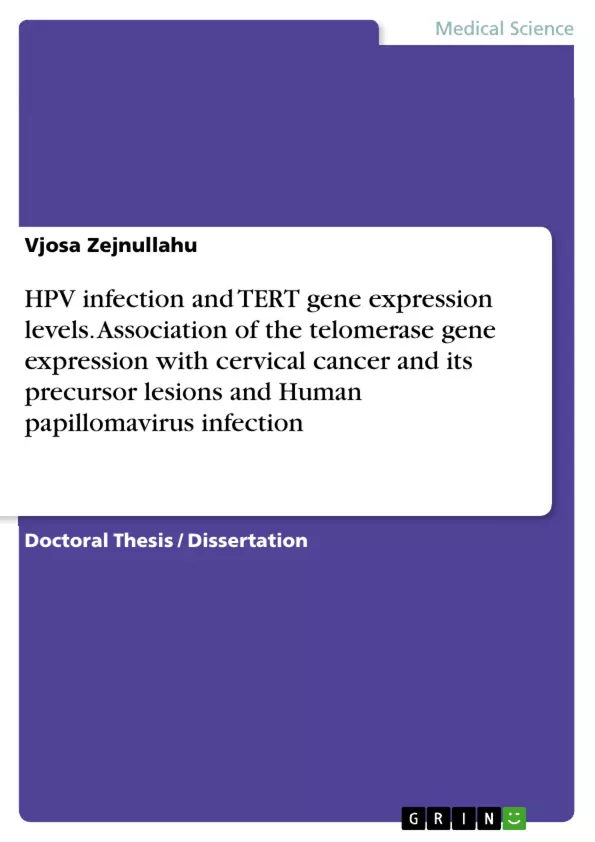The aim of this study is to evaluate the frequency of HPV infection and genotypes among women with normal and abnormal cytological results and its correlation according to the severity of the lesions as well as to investigate the correlation between the TERT gene expression levels and the cytological sub-group and to evaluate the correlation between the HPV infection and TERT gene expression levels as diagnostic and prognostic marker in cervical precursor lesions and cervical cancer.
Early events associated with disease progression and cervical cancer include hTERT up-regulation at the transcriptional level mediated by high-risk HPV E6 oncoproteins via indefinite mechanisms with concomitant immortal phenotype of the cell in vitro and increased replicative potential of cells in precancerous cervical lesions and cervical cancer. Materials and methods: This study is a prospective observational case-control study conducted in Obstetrics and Gynaecology Clinic in Pristina and Molecular and Biology-Genetics Department in Skopje. Cervical samples from 214 women (median age 45.28 years; range 20-65) from the Outpatient Clinic in University Clinical Center in Kosovo were tested for HPV-DNA and quantitative TERT gene expression after performing conventional Pap smear.
Inhaltsverzeichnis (Table of Contents)
- ABSTRACT
- List of acronyms and abbreviations
- INTRODUCTION
- BACKGROUND
- Cervix uteri and the squamocolumnar junction
- CERVICAL DISEASE AND NEOPLASIA
- CERVICAL PRECURSOR LESIONS
- SCREENING
- HPV testing in primary screening.
- Management of cervical precursor lesions – treatment..
- Follow-up after treatment.
- Human papillomaviruses (HPVs)
- HPV genome organisation
- Early genes E1, E2, E4-E7.
- Late proteins L1/L2.
- HPV life cycle.
- Epidemiology of the HPV infection and its role in malignant transformation..........
- Host immune response and HPV infection
- Evasion mechanism of HPV
- HPV vaccines
- Telomere structure...
- Telomerase activity and malignant transformation.
- MOTIVATION FOR THE RESEARCH
- RESEARCH HYPOTHESIS.
- AIMS OF THE STUDY.
- The specific aims of the research
- MATERIALS AND METHODS.
- Ethics
- Inclusion and exclusion criteria.
- Preconditions for the screening..
- Population
- Control group characteristics...........
- Data collection..........\li>
- MOLECULAR analyses.
- DNA and RNA isolation..........\li>
- HPV detection and genotyping...........
- Quantitative Real-Time PCR for telomerase gene expression .....
- Statistical analysis...
- RESULTS.
- DISCUSSION.
- CONCLUSIONS.
- REFERENCES.
Zielsetzung und Themenschwerpunkte (Objectives and Key Themes)
This doctoral dissertation investigates the association between telomerase gene expression and cervical cancer, its precursor lesions, and Human papillomavirus (HPV) infection. The study aims to contribute to the understanding of the role of telomerase in the development of cervical cancer and its relationship with HPV infection.
- The role of telomerase in cervical cancer development
- The association between telomerase expression and cervical precursor lesions
- The relationship between telomerase expression and HPV infection
- The potential for telomerase as a biomarker for cervical cancer risk
- The implications of these findings for cervical cancer prevention and treatment
Zusammenfassung der Kapitel (Chapter Summaries)
- Introduction: This chapter provides an overview of cervical cancer, its precursor lesions, and the role of HPV infection in its development. It also introduces the concept of telomerase and its potential involvement in the disease process.
- Background: This chapter delves into the biological context of cervical cancer, including the anatomy of the cervix, the mechanisms of HPV infection, and the progression of cervical precursor lesions. It also explores the epidemiology of HPV infection and the effectiveness of HPV vaccines.
- Motivation for the research: This chapter outlines the rationale for the research study, emphasizing the gaps in current knowledge about the relationship between telomerase and cervical cancer.
- Research hypothesis: This chapter states the hypothesis that telomerase gene expression is associated with cervical cancer and its precursor lesions, and that this association is influenced by HPV infection.
- Aims of the study: This chapter outlines the specific objectives of the research study, which aim to investigate the association between telomerase expression, cervical cancer, and HPV infection in a cohort of women.
- Materials and Methods: This chapter details the study design, participant recruitment, data collection methods, and laboratory procedures used in the research. This includes information about ethical considerations, inclusion and exclusion criteria, and molecular analyses, such as DNA and RNA isolation, HPV detection and genotyping, and quantitative real-time PCR for telomerase gene expression.
- Results: This chapter presents the findings of the research study, analyzing the relationship between telomerase gene expression, cervical cancer, and HPV infection.
Schlüsselwörter (Keywords)
The main keywords and focus topics of this research include cervical cancer, telomerase, human papillomavirus (HPV), HPV infection, cervical precursor lesions, molecular biology, genetics, epidemiology, and biomarkers. The study emphasizes the relationship between telomerase gene expression, cervical cancer development, and HPV infection, exploring potential implications for cervical cancer prevention and treatment.
- Citar trabajo
- Vjosa Zejnullahu (Autor), 2018, HPV infection and TERT gene expression levels. Association of the telomerase gene expression with cervical cancer and its precursor lesions and Human papillomavirus infection, Múnich, GRIN Verlag, https://www.grin.com/document/1193090



